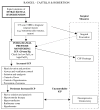Management of intracranial hypertension
- PMID: 18514825
- PMCID: PMC2452989
- DOI: 10.1016/j.ncl.2008.02.003
Management of intracranial hypertension
Erratum in
- Neurol Clin. 2008 Aug;26(3):xvii. Rangel-Castillo, Leonardo [corrected to Rangel-Castilla, Leonardo]
Abstract
Effective management of intracranial hypertension involves meticulous avoidance of factors that precipitate or aggravate increased intracranial pressure. When intracranial pressure becomes elevated, it is important to rule out new mass lesions that should be surgically evacuated. Medical management of increased intracranial pressure should include sedation, drainage of cerebrospinal fluid, and osmotherapy with either mannitol or hypertonic saline. For intracranial hypertension refractory to initial medical management, barbiturate coma, hypothermia, or decompressive craniectomy should be considered. Steroids are not indicated and may be harmful in the treatment of intracranial hypertension resulting from traumatic brain injury.
Figures
References
-
- Doczi T. Volume regulation of the brain tissue—a survey. Acta Neurochir (Wien) 1993;121:1–8. - PubMed
-
- Langfitt TW, Weinstein JD, Kassell NF. Cerebral vasomotor paralysis produced by intracranial hypertension. Neurology. 1965;15:622–41. - PubMed
-
- Miller JD, Sullivan HG. Severe intracranial hypertension. Int Anesthesiol Clin. 1979;17:19–75. - PubMed
-
- Welch K. The intracranial pressure in infants. J Neurosurg. 1980;52:693–9. - PubMed
-
- Andrews BT, Chiles BW, III, Oslen WL, et al. The effect of intracerebral hematoma location on the risk of brain stem compression and on clinical outcome. J Neurosurg. 1988;69:518–22. - PubMed
Publication types
MeSH terms
Grants and funding
LinkOut - more resources
Full Text Sources
Other Literature Sources
Medical


